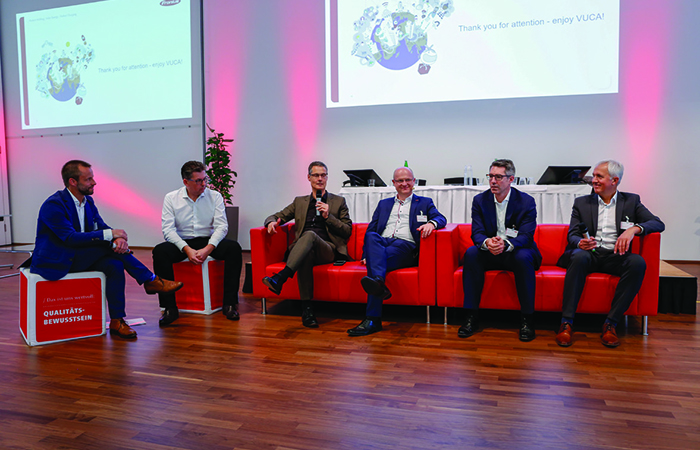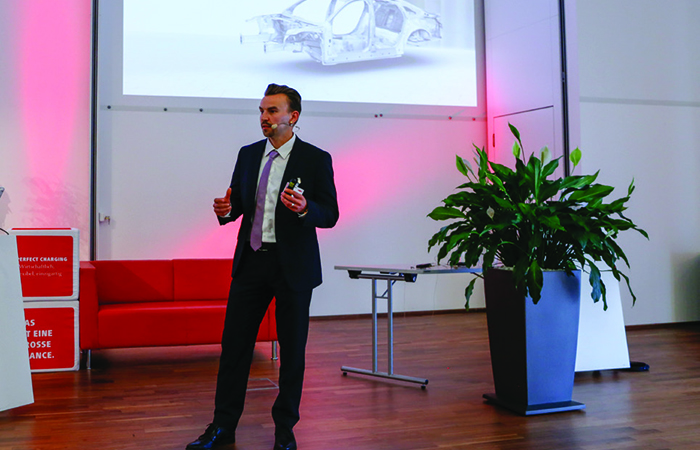“Joining Smart Technologies” automotive conference at Fronius
On May 8 and 9, Fronius hosted the sixth international automotive conference in Sattledt, Upper Austria. Alongside automotive engineering experts, the speakers included luminaries from the area of digitalisation, all of whom made the future of automotive manufacture in the digital revolution more tangible for those in attendance.
Digitalisation was the central topic for this year’s “Joining Smart Technologies” conference. Over a hundred delegates from ten countries used the conference to exchange their knowledge and experiences and appeared inspired by the high-quality presentations and networking opportunities.
Standardisation and Personalisation
At the start of the conference, Thomas Bauernhansl, Head of the Fraunhofer Institute for Manufacturing Engineering and Automation, gave his insights into the current state of automotive engineering within the digital revolution. His central theme was: Data in the factory of tomorrow. Data will play a key role, whether for standardised products or mass-produced products in the future, driverless taxis, or heavily customised cars for end customers. In relation to this, Bauernhansl primarily appealed directly to the conscience of businesses: “For machine learning, data is the raw material used to generate machine algorithms. The data quality therefore plays a decisive role for the entire process.”
The Smart Arc
Christian Kotschote, Technology Developer at Audi, reported on the potential for connectivity in the area of thermal welding, underlining that digital systems have the potential to increase the output of arc applications. To do so, all information needs to be made usable right along the entire process chain, including the steps before and after welding.
Following on from this point, Helmut Ennsbrunner, Head of Pre-Development at Fronius, set out what the digital transformation means from the perspective of a welding systems manufacturer. Ennsbrunner explained that digitalisation enables data to be reproduced without loss and exchanged with partners. This opens up new opportunities for collaboration: on one hand, automated machines should be able to work together more efficiently; on the other, information can be shared between suppliers, customers, and other partners, and used for new cooperative business models.
Teamwork with Robots
Martina Mara’s presentation also focused on cooperation: as a tech psychologist and Professor of Robopsychology at Johannes Kepler University Linz Martina works predominantly with cooperation between humans and robots.

At the panel discussion, the conference leaders pointed out that the digital systems of the future should not only be able to support technical quality but also sustainable solutions

Christian Kotschote from Audi pointed out that connectivity in production can increase the output of welding processes
At the automotive conference, she stressed that being able to predict how machines will interact with humans is crucial in determining how efficiently human-machine teams will work together.
In the panel discussion that followed, Florian Oefele, Senior Manager Virtual Commissioning and Digitalisation Assembly at BMW, also placed humans at the centre of the digital revolution. Only openness, trust, and responsibility can enable us to exploit the opportunities offered by digitalisation. Michael Zürn, Senior Manager Process Engineering at Daimler, specified precisely where these opportunities lie: “Data helps us humans to master complexity and therefore to make better decisions more easily.” In the industrial environment this helps shorten production times and optimize costs and quality. Furthermore, representatives of the OEMs took a look into the future and agreed that sustainability is gaining in significance. In the future, digital solutions like blockchain could also help to bring transparency to quality in terms of social aspects and sustainability.











Radio wave weapon knocks out drone swarms
Probably. A radio-controlled drone cannot be completely shielded to RF, else you´d lose the ability to control it. The fibre optical cable removes...